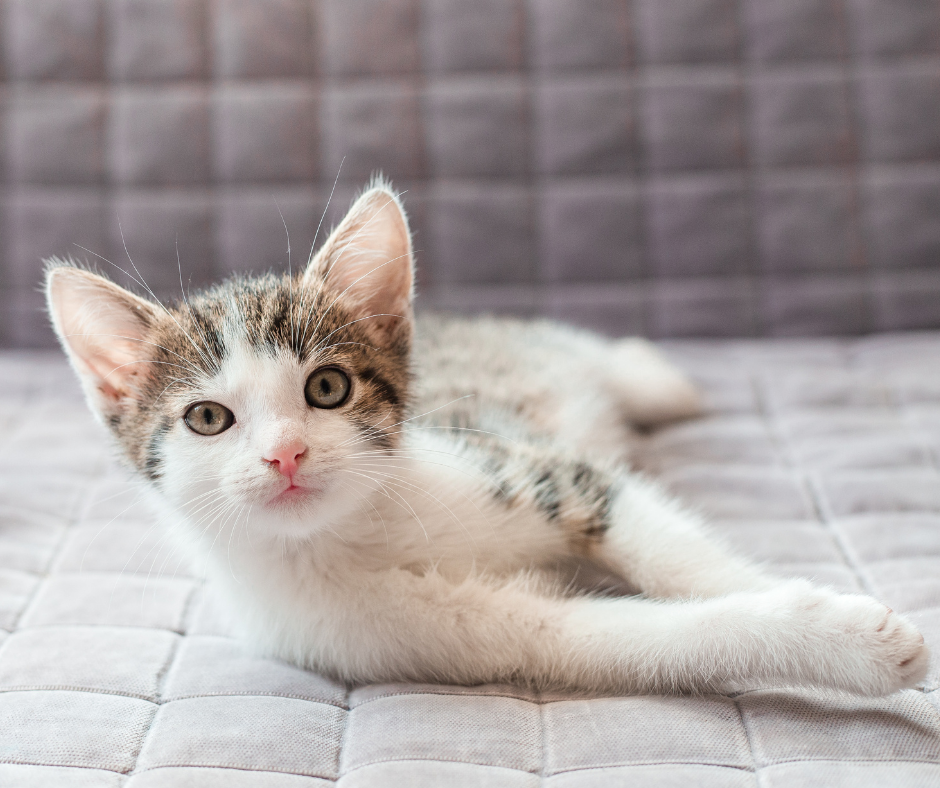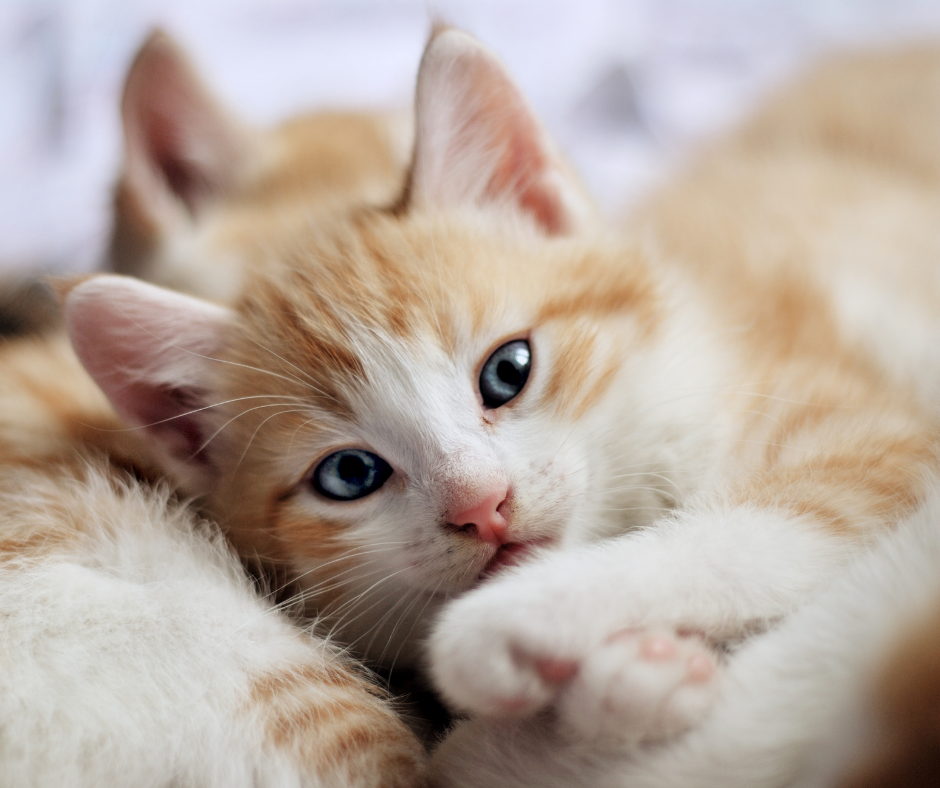Welcoming a new pet to your fur family is an exciting time! Kittens should stay with their mum until they are at least 8 weeks old, so they can learn important behaviours from her and their siblings. 10 weeks is generally the recommended age to bring your new pet home. Whether you’re a newbie owner or it’s been a while since you had a new kitten, we’ve put together a handy checklist of what you will need to get started.
Checklist for a new kitten
- Kitten carrier for the journey home ❤ Equipped with newspaper in case of accidents, and a blanket to keep cosy. Longer term, cats can benefit from cat carrier training to make the experience less stressful.
- Complete, balanced kitten diet. We recommend feeding the same diet that your kitten has eaten with the breeder. If you want to introduce a new food, do so very gradually by mixing in small portions with their old food. Avoid sudden dietary changes as this can lead to diarrhoea and vomiting.
- Litter tray with low sides for tiny legs! Find out more about choosing a litter tray here .
- Kitten-friendly cat litter. Opt for a non-clumping, fragrance-free product.
- Kitten-safe toys. Your local pet shop will be able to offer advice about the best options for your kitty.
- Beds and safe spaces to hide. Felines like a variety of spots to rest, ranging from ‘hidey houses’ and cat trees, to more traditional cat beds.
- Bowls for food and water. Kittens may find shallower bowls easier at first.
- Break-away collar and ID tag. It is important that the collar will come free if it catches, to avoid accidents and injuries.
- Pet-safe cleaning products. You will need a non-toxic but effective spray to clean out the litter tray.
- Kitten brush or comb. This is particularly important for long-haired kittens, but all breeds will benefit from getting used to grooming early on to help avoid painful knots.
- Finding a vet nearby. The RCVS Find a Vet tool is a handy feature to find local practices.
- Pet Insurance and Health Plans. Veterinary care can be costly, but pet insurance can help provide peace of mind should the unexpected happen. Vet practices sometimes offer health plans which can include discounts on routine treatments.
- Kitten-proofing your home and garden. More on this below.
Kitten health check
Register your kitten with a local vet clinic and get a kitten health check booked in for a few days after you first bring them home. This gives a bit of time to keep an eye on them and identify any questions you might have about their health or behaviour. You can make an appointment earlier if you are worried about your pet, or if they have vaccines due. The RCVS Find a Vet feature will help you locate your nearest veterinary practices.

Take along any paperwork about your kitty to this appointment, such as their vaccination record. You can also bring a note of the diet you are feeding, plus the names of any flea or worm treatments your pet has been given and the dates that these were administered.
During the first appointment, the vet will ask you some questions which is referred to as ‘taking a history’. They will then check your kitten’s different body systems, including listening to their heart and lungs, and checking for any congenital or developmental problems (physical conditions that your pet has been born with). Your vet will flag up any potential health concerns and provide advice on vaccinations and how to prevent fleas and worms. You can also ask your vet any questions you have about caring for your kitten, including their diet and training, and whether the practice offers pet health plans.
A cat microchip is not compulsory, unlike in dogs, but it is highly recommended to help reunite you with your cheeky pet if they go wandering off. A kitten vaccination schedule involves a course of two injections, usually given at 9 and 12 weeks of age. Your new pet may already have had the first vaccine before you bring them home, so this is worth checking with the breeder. Kitten vaccination cost varies between practices, but you can ask for prices over the phone and check whether the clinic offers a new kitten plan.
The recommended age to neuter a cat is generally 4-6 months old, although your kitten may need to reach a minimum weight before the surgery. Females can become pregnant as early as 6 months old, so it is best to get them spayed before they are allowed outside unsupervised. Male cat neutering is usually referred to as castration.
How much should I feed my kitten?
You should be feeding your fab feline a kitten diet until they are 1 year old. Generally, it’s best to stick with the food they have been fed by the breeder to begin with. This is because sudden dietary changes can lead to diarrhoea, and sometimes vomiting. This is a particular problem in young pets as they are more at risk of becoming rapidly dehydrated – leading to an unwanted trip to the vet.
There will usually be a feeding guide on the pet food packaging. This will explain how much food to feed your kitten as they grow, and how many meals a day they need. Kittens will start off on wet food as they are weaned, but may already have been introduced to kibble by the time you welcome them home. You can read more about wet vs dry food in our detailed guide.
It is essential that kittens are fed diets that are appropriate for their life stage, and not an adult cat food. This is because they have different nutritional requirements – for example, since they’re growing very rapidly they’ll need more calories and protein.
How to litter box train a kitten
You can start litter training right away. Your inquisitive kitty should have picked up some toileting behaviours from their mum, and the breeder may already have started the litter training process. It can work well to use the same type of cat litter as the breeder, because they will already be used to this. Learn more about litter training a kitten here.

Kitten proofing my home and garden
- Store cleaning products, medicines, garden products and other hazardous chemicals out of reach of your pets. The same goes for any human foods that are unsafe for cats to eat such as chocolate, garlic, onions and raisins. Bear in mind that felines are pretty awesome climbers, so it is better to keep these behind closed doors rather than on open shelves.
- Research which house and garden plants could pose a risk to your kitten. Remove any toxic houseplants, or keep them well out of reach. Poisonous garden plants should also be removed, or effectively fenced-off, otherwise your pets will need supervising in the garden.
- Close the lid to toilets, laundry baskets and bins to make sure adventurous kitties don’t fall inside.
- Take care with electronics. Try to reduce the number of wires in the room where your kitten will be left alone when you are out, as these can be tempting to chew. You could also consider using socket covers.
- Avoid choking hazards. Make sure to tidy away small items, especially if your kitten is going to be left unattended.
Ensure that garden fences are tall enough to prevent young kittens from escaping, and fill in any holes. Realistically, once your kitty is older, they will be able to jump heights of several feet. However, kittens should be prevented from roaming until they are around 6 months of age, and have been neutered and vaccinated. Until this point, they should be supervised in the garden. To be on the safe side, any water features should also be fenced off.
Love a good freebie? Sign up to our mailing list below to be the first to know about great pet offers.


